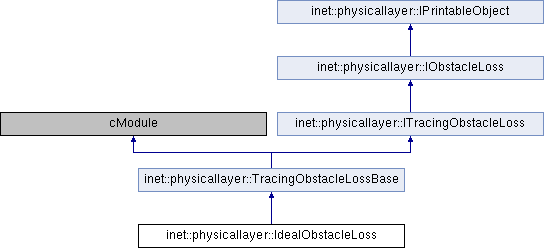#include <IdealObstacleLoss.h>

Classes | |
| class | TotalObstacleLossComputation |
Public Member Functions | |
| IdealObstacleLoss () | |
| virtual std::ostream & | printToStream (std::ostream &stream, int level) const override |
| Prints this object to the provided output stream. More... | |
| virtual double | computeObstacleLoss (Hz frequency, const Coord &transmissionPosition, const Coord &receptionPosition) const override |
| Returns the obstacle loss factor caused by physical objects present in the environment as a function of frequency, transmission position, and reception position. More... | |
 Public Member Functions inherited from inet::physicallayer::IPrintableObject Public Member Functions inherited from inet::physicallayer::IPrintableObject | |
| virtual | ~IPrintableObject () |
| virtual std::string | getInfoStringRepresentation () const |
| virtual std::string | getDetailStringRepresentation () const |
| virtual std::string | getDebugStringRepresentation () const |
| virtual std::string | getTraceStringRepresentation () const |
| virtual std::string | getCompleteStringRepresentation () const |
Protected Member Functions | |
| virtual void | initialize (int stage) override |
| virtual bool | isObstacle (const IPhysicalObject *object, const Coord &transmissionPosition, const Coord &receptionPosition) const |
Protected Attributes | |
Parameters | |
| IRadioMedium * | medium = nullptr |
| The radio medium where the radio signal propagation takes place. More... | |
| IPhysicalEnvironment * | physicalEnvironment = nullptr |
| The physical environment that provides to obstacles. More... | |
Additional Inherited Members | |
 Public Types inherited from inet::physicallayer::IPrintableObject Public Types inherited from inet::physicallayer::IPrintableObject | |
| enum | PrintLevel { PRINT_LEVEL_TRACE, PRINT_LEVEL_DEBUG, PRINT_LEVEL_DETAIL, PRINT_LEVEL_INFO, PRINT_LEVEL_COMPLETE = INT_MIN } |
 Static Public Attributes inherited from inet::physicallayer::ITracingObstacleLoss Static Public Attributes inherited from inet::physicallayer::ITracingObstacleLoss | |
| static simsignal_t | obstaclePenetratedSignal = cComponent::registerSignal("obstaclePenetrated") |
Constructor & Destructor Documentation
Member Function Documentation
|
overridevirtual |
Returns the obstacle loss factor caused by physical objects present in the environment as a function of frequency, transmission position, and reception position.
The value is in the range [0, 1] where 1 means no loss at all and 0 means all power is lost.
Implements inet::physicallayer::IObstacleLoss.
|
overrideprotectedvirtual |
|
protectedvirtual |
Referenced by inet::physicallayer::IdealObstacleLoss::TotalObstacleLossComputation::visit().
|
overridevirtual |
Prints this object to the provided output stream.
Function calls to operator<< with pointers or references either const or not are all forwarded to this function.
Reimplemented from inet::physicallayer::IPrintableObject.
Member Data Documentation
|
protected |
The radio medium where the radio signal propagation takes place.
Referenced by initialize().
|
protected |
The physical environment that provides to obstacles.
Referenced by computeObstacleLoss(), and initialize().
The documentation for this class was generated from the following files:
